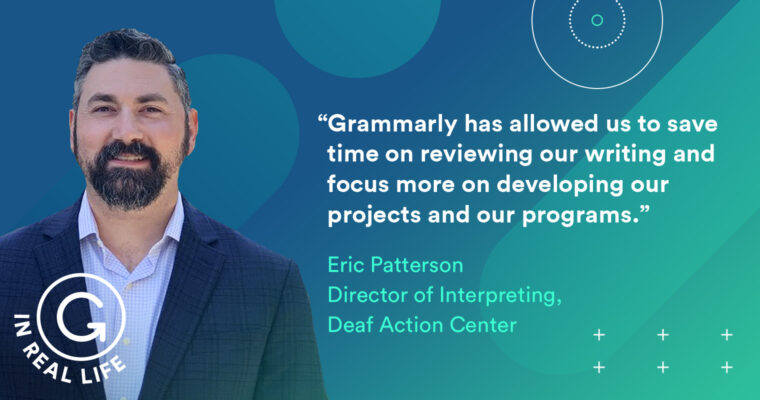
I’ve supported internal communications both officially (as a Senior Communications Manager) and unofficially (as an Executive Assistant who managed all office communications) for nearly a decade. At any given moment, I’ve had my hands in multiple tasks, including all-staff emails, newsletter updates, blurbs for the company intranet or wiki, ghostwritten updates from the CEO, and more. The work of internal communications is simultaneously exhilarating and exhausting.
It can be a lot to manage, especially as a team of one. There have been many times I wished for a second pair of eyes, to no avail. In my earliest corporate days, when I was unaware of Grammarly’s existence, I didn’t have it to rely on. Now? It’s a tool I can’t live without, and one I recommend to every internal communicator. Grammarly helps me improve message clarity, edit drafts more efficiently, and ensure consistency to maintain trustworthy and on-brand internal communications.
Here’s how Grammarly made me a more effective internal comms pro:
1. Makes every message count
In internal communications, writing the first draft is only half the battle. The magic usually lies in editing and polishing the message, ensuring it meets your audience where they are and drives an action, response, or behavioral change.
That’s where Grammarly comes into play. Grammarly enhances every internal communications draft, whether it’s an email, Slack message, newsletter, or other medium, through its suggestions for grammar, tone, and clarity. With Grammarly, I can ensure messages are consistent and will land with impact.
One of my favorite ways to work with CEOs is to collaborate with them on their emails via Google Docs. I worked with a CEO who enjoyed adding his voice and personal anecdotes to his emails. I’d then use Grammarly to refine his sentences, transforming long-winded phrasing into confident, concise sentences.
2. Prevents costly typos in high-visibility communications
Every internal communicator I know (myself included) fears sending an email from the CEO with an embarrassing typo. Credibility is a critical component of effective internal communications, and Grammarly helps minimize this risk and fear.
My scariest moment: (Almost) sending a finalized email draft about a company restructuring with “reorganization” spelled “reoranization” in the subject line …
Grammarly’s spelling and grammar checks and its AI rewrite suggestions are the perfect final step in a proofreading workflow. It’s a great second pair of eyes to help you catch those pesky typos, missing commas, confusingly worded sentences, and more.
3. Creates more time for strategy
As internal communicators continue to evolve into influential business partners, supporting organization-wide changes and key messages, they require more time to focus on internal communications strategy, message cascades, and effective change communication techniques.
One thing I love about Grammarly is that I can use the generative AI tools to create, rewrite, and jump-start the content creation process. These features have been a game-changer for quickly creating templates, such as an FAQ template for managers before an all-hands announcement. It allows me to make a basic template (with suggestions of what I might cover), freeing up time for me to focus on the strategic wording I’ll insert into the FAQ document.
Here’s a prompt I’ve used for you to try: Create an FAQ template I can share with managers about an upcoming org-wide policy change we’re rolling out soon.
Ultimately, the generative AI tools save me time outlining and creating a messaging format, allowing me to focus on my favorite part: the writing.
4. Prioritizes plain and inclusive language
Grammarly offers inclusive and plain language suggestions, updating its features to reflect changes, enabling users to learn language norms and communicate more effectively and empathetically.
This feature is beneficial for teams that lean heavily on slide decks as part of their internal communications and announcement strategy. For example, I’ve edited copy for slide decks announcing org-wide changes, including a reorganization, to replace instances of passive voice with active voice.
It’s a matter of replacing “Departmental functions will be realigned for cross-functional collaboration” with “Executive leadership is realigning departmental functions for cross-functional collaboration,” for ownership, accountability, and clarity.
5. Follows me across platforms
Managing communications across multiple channels? No problem! Grammarly provides real-time writing assistance and one consistent communication layer across 500,000+ apps and sites. That means you can edit your drafts directly within many of your favorite platforms.
I’ve encouraged leaders I’ve worked with to be more active and visible in Slack. One leader I worked with wrote his Slack messages in real time but often wanted a quick review before posting. He’d send me his drafts via direct message, and I could quickly copy the message, revise it using Grammarly, and send it right back to him to post, all without ever leaving Slack.
There’s no need for context switching, sacrificing message quality, or copying and pasting until your fingers are tired, because Grammarly works with you, wherever you are.
Grammarly is a strategic ally for internal communicators who refuse to do more than “make it pretty” and “just send the email.” Great internal communication starts with excellent writing, and Grammarly gives internal communicators the edge to make every word count.
Alyssa Towns is a Denver-based writer and communications professional and Grammarly Ambassador. Check out her portfolio at wordswithalyssa.com.






